|
Gustavo presented a talk on his dissertation research titled Bromeligenous Amphibians in Suboptimal Habitats: A Case Study of Phyllodytes gyrinaethes and its Environmental Interactions during our annual Biosymposium at the BBC campus.
0 Comments
Congrats to Jon for passing his qualifying exams! Jon is now a PhD candidate.
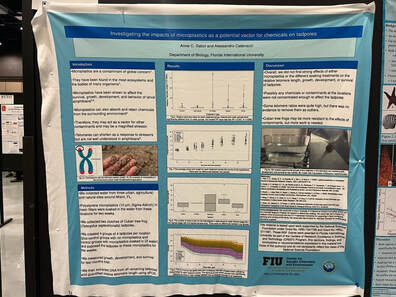 Anne presented at the Society for Integrative and Comparative Biology 2024 annual meeting in early January in Seattle, WA. She presented a poster about her work investigating the effects of microplastics on tadpoles titled “Investigating the impacts of microplastics as a potential vector for chemicals on tadpoles”. 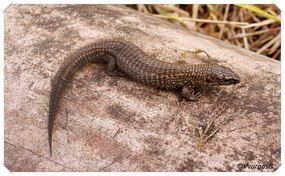 The last taxonomic contribution of the lab in 2023 is a collaboration with the description of two new species of lizards in the genus Petracola from Peru, led by Luis Mamani. The two new species are Petracola amazonensis and P. shrugojalcapi (shown in the picture by V. Vargas). The two new species increase the diversity of Petracola to seven species. However, like other genera of gymnophthalmids, the diversity is still underestimated. Citation: Mamani, L. , V. J. Vargas, J.C. Chaparo, A. Catenazzi. Two new species of gymnophthalmid lizards (Squamata: Cercosaurinae) from the Andes of Peru and their phylogenetic relationships. Amphibian and Reptile Conservation 17(1-2): : 161–173 (e328).
Lab collaborator Valia Herrera-Alva published today the description of a new species of terrestrial-breeding frog, Pristimantis similaris from the montane forests of southern Peru. The species is cryptic (hence the name) with P. rhabdolaemus and P. pharangobates, also distributed in southern Peru, but molecular analyses and careful examination of their external morphology allowed Valia to set them apart. Pristimantis similaris is a member of the family Strabomantidae, a group of small, ground-dwelling frogs found throughout the tropical Americas. The new species is distinguished by its small size (less than an inch in length), rough skin, and long, slender legs. It also has a distinctive oval-shaped tongue, which it uses to snatch insects from the leaf litter. The discovery of Pristimantis similaris highlights the incredible biodiversity of the Peruvian cloud forests, a hotspot for amphibian endemism. These fragile ecosystems are home to hundreds of frog species, many of which are found nowhere else on Earth. "The cloud forests of Peru are a treasure trove of undiscovered life," said Valia. "This new frog is a reminder that there is still so much we don't know about the natural world, and that even the most common-looking creatures can hold hidden secrets." The scientists who discovered Pristimantis similaris are calling for increased conservation efforts in the Peruvian cloud forests. These irreplaceable ecosystems are threatened by deforestation, climate change, and other human activities. "We need to do more to protect these cloud forests," said Valia. "They are not only home to a wealth of biodiversity, but they also play an important role in regulating the climate and providing clean water. By protecting the cloud forests, we are protecting the future of our planet." The discovery of Pristimantis similaris is a testament to the power of scientific curiosity and the importance of protecting our planet's biodiversity. With continued research and conservation efforts, we can ensure that these remarkable creatures continue to thrive for generations to come. Citation: Herrera-Alva, V., A. Catenazzi, C. Aguilar-Puntriano. 2023. A new cryptic species of terrestrial breeding frog of the Pristimantis danae Group (Anura, Strabomantidae) from montane forests in Ayacucho, Peru. ZooKeys 1187: 1-29.
doi: 10.3897/zookeys.1187.104536  Alessandro was host to Emanuele Biggi's live TV show Geo, and spoke about amphibian declines, their ecological consequences, and the paradox of species discoveries (and rediscoveries) as many more are lost due to habitad destruction, disease, and climate change. The interview (in italian) can be seen online at https://www.raiplay.it/programmi/geo. 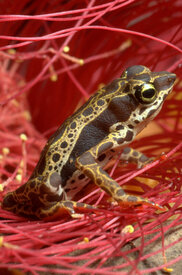 Our planet is home to almost 9,000 amphibian species. For more than 100 years, these animals have dramatically suffered the consequences of deforestation, agriculture, wetland drainage, agrochemicals and other pollutants. In recent times, new threats have emerged making 40% of all amphibian species threatened with extinction under “Red List” released by the International Union for the Conservation of Nature (IUCN), which was recently updated. New threats include climate change and emerging infectious diseases. Among them, amphibian chytrid fungi causing skin infections play a key role. These fungi have been spread all over the world by humans and induce the disease chytridiomycosis in amphibians, leading to population declines and even extinctions. Already 30 years ago, researchers, conservationists and other stakeholders have realized the crisis the amphibians are in. Various initiatives, at the global, regional and local scales have been founded to safeguard amphibian diversity including numerous management and action plans. Due to these activities, we massively augmented our knowledge about where declines happen, as well as the mechanisms behind these and how threats interact. This goes hand in hand with enormous engagement for protecting natural habitats and accompanying captive breeding in conservation facilities. Also, diseases and their agents are much better understood. There have been many stories of success and without all the investment, work and passion of dedicated actors many amphibian species would have become extinct by now! However, it is difficult to appreciate where we stand in overcoming the amphibian crisis. Threats and the vulnerability to them are not equally distributed over all species. Certain amphibians are more susceptible and suffer more. They represent ‘worst-case scenarios’ of the amphibian crisis. For many of them, we lack sufficient information to access their current status. Not so for harlequin toads, genus Atelopus, from Central and South America. These are small, often colorful and day-active animals that inhabit lowland rainforests to high Andean moorlands (páramos) above tree line. More than 130 Atelopus species are known and – being highly sensitive to threats – many of them have declined and are even feared extinct. Harlequin toads are the poster child of the amphibian crisis, and due to their iconic appearance, scientists have studied population status data since the early 1990s. In a recent study published in Communications Earth and Environment , Lötters and 99 colleagues, mostly conservationists and researchers from countries where harlequin toads naturally occur, compared population status data as of 2004 and of 2022 to examine species-specific trends over the last two decades. Data from the authors confirm that massive conservation efforts from many scientists, conservationists and local communities have revealed that more than 30 Atelopus species that in part were feared to have vanished are still there! However, evidence suggests that at the same time all species remain threatened and their conservation status has not improved. Factors threatening the remaining harlequin toads remain unchanged and include habitat change and chytrid fungus spread. In addition, the authors demonstrated that in the future harlequin toads suffer from climate change. Authors conclude that other worst-case amphibians continue to be imperiled demonstrating that the amphibian crisis is still an emergency. Thanks to the tremendous strength put into conservation, by collaborative networks like the recently launched Atelopus Survival Initiative under the umbrella of the Atelopus Task Force of the IUCN Amphibian Specialist Group, these amphibians have not yet vanished. It is now more than ever critical to continue and increase efforts to escape the emergency the amphibian crisis still is. Citation: Lötters, S., A. Plewnia, A. Catenazzi, K. Neam, A.R. Acosta-Galvis, Y. Alarcon Vela, J.P. Allen, J.O. Alfaro Segundo, A. de Lourdes Almendáriz Cabezas, G. Alvarado Barboza, K.R. Alves-Silva, M. Anganoy-Criollo, E. Arbeláez Ortiz, J.D. Arpi L., A. Arteaga, O. Ballestas, D. Barrera Moscoso, J.D. Barros-Castañeda, A. Batista, M.H. Bernal, E. Betancourt, Y.O. da Cunha Bitar, P. Böning, L. Bravo-Valencia, J.F. Cáceres Andrade, D. Cadenas, J.C. Chaparro Auza, G.A. Chaves-Portilla, G. Chávez, L.A. Coloma,C.F. Cortez-Fernandez, E.A. Courtois, J. Culebras, I. De la Riva, V. Diaz, L.C. Elizondo Lara, R. Ernst, S.V.Flechas, T. Foch, A. Fouquet, C.Z. García Méndez, J. E. García-Pérez, D.A. Gómez-Hoyos, S.C. Gomides,J. Guerrel, B. Gratwicke, J.M. Guayasamin, E. Griffith, V. Herrera-Alva, R. Ibáñez, C.I. Idrovo, A. Jiménez Monge, R.F. Jorge, A. Jung, B. Klocke, M. Lampo, E. Lehr, C.H.R. Lewis, E.D. Lindquist, Y.R. López-Perilla, G. Mazepa, G.F. Medina-Rangel, A. Merino Viteri, K. Mulder, M. Pacheco-Suarez, A. Pereira-Muñoz, J.L. Pérez-González, M.A. Pinto Erazo, A.G. Pisso Florez, M. Ponce, V. Poole, A.B. Quezada Riera, A.J. Quiroz, M. Quiroz-Espinoza, A. Ramírez Guerra, J.P. Ramírez, S. Reichle, H. Reizine, M. Rivera-Correa, B. Roca-Rey Ross, A. Rocha-Usuga, M.T. Rodrigues, S. Rojas Montaño, D.C.Rößler, L.A. Rueda Solano, C. Señaris, A. Shepack, F.R. Siavichay Pesántez, A. Sorokin, A. Terán-Valdez, G. Torres-Ccasani, P.C. Tovar-Siso, L.M. Valencia, D.A. Velásquez-Trujillo, M. Veith, P.J. Venegas, J. Villalba-Fuentes, R. von May, J.F. Webster Bernal & E. La Marca. 2023. Ongoing harlequin toad declines suggest the amphibian extinction crisis is still an emergency. Communications Earth and Environment, 4, 412. doi: https://www.nature.com/articles/s43247-023-01069-w
The lab was present at the XII Congreso Latinoamericano de Herpetologia in Cochabamba the first week of November. Alessandro participated as part of the scientific outreach activities for NSF project DEB 2003497. These are the talks and poster presented by students and collaborators during the meeting. 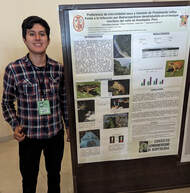 Hamlet Maza presented a poster on his work on the role of fungal infection on substrate choice behavior in terrestrial breeding frogs titled Preferencia de microhábitat seco y húmedo en anuros de reproducción terrestre infectados por Batrachochytrium dendrobatidis en el bosque montano del valle de Kosñipata, Perú. 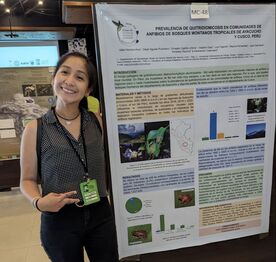 Valia Herrera presented her poster on chytrid prevalence in cloud forests of southern Peru, titled Prevalencia de quitridiomicosis en comunidades de anfibios de bosques montanos tropicales de Ayacucho y Cusco, Perú. 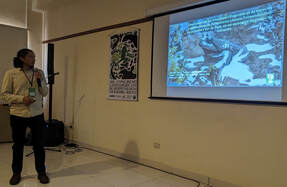 Alex Ttito gave a talk summarizing his research on the phylogeny of high Andean water frogs: Desenredando las relaciones filogenéticas de especies y poblaciones de Telmatobius (Anura: Telmatobiidae) en el centro y sur de Perú en un escenario de riesgo de extinción. Alessandro gave two talks, one on the ongoing mark-recapture study investigating fungal transmission in terrestrial-breeding frogs, and the second on frog-biting midges (Corethrellidae) in the montane forests of the Amazonian slopes of the Andes: 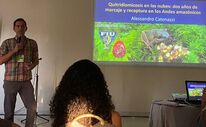 Quitridiomicosis en las nubes: Dos años de marcaje y recaptura de ranas de desarrollo directo en los Andes amazónicos 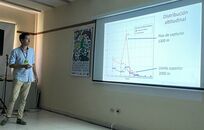 Aproximaciones ecológicas a los mosquitos picadores de ranas (Corethrellidae) en los Andes amazónicos Alessandro also presented a poster on the work of AmphibiaWeb: AmphibiaWeb: Conectando a los amantes de los anfibios con la información.
Congratulations to Anne for being awarded a University Graduate School Dissertation Year Fellowship! This competitive award allows last year PhD candidates at FIU to dedicate themselves to writing their dissertations.
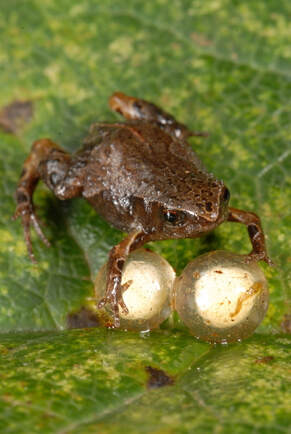 Amphibians are in trouble and in desperate need of conservation action, according to a new global assessment of the world’s amphibian population. Salamanders are experiencing the greatest decline in numbers, but amphibians throughout the Neotropics are of particular concern, according to Alessandro Catenazzi, FIU biologist and one of the primary researchers on the international project. The team evaluated the status of 8,011 species of amphibians tracked by the International Union for Conservation of Nature (IUCN). Their findings, published this week in Nature, indicate nearly 41percent of amphibian species are threatened with extinction, making them the most imperiled class of vertebrates on the planet, outpacing birds and mammals. Since 1980, at least 37 species have gone extinct, with disease and habitat loss being the primary culprits. The scientists warn climate change is quickly emerging as a major threat, attributing to 39 percent of populations declines since 2004. "Global emerging diseases increasingly threaten biodiversity worldwide, and amphibians are one of the most dramatic examples of species extinctions caused by disease. No other group of vertebrates has been so negatively affected by a single disease" says Catenazzi. "We urgently need better strategies to prevent pandemics and mitigate the effects of introduced disease on wild amphibians" While the news is not good for amphibians, the scientists do offer hope in this latest assessment. Enforced habitat protections actually resulted in status improvements for some species, indicating this should be a conservation priority, especially in regions where agriculture, timber and plant harvesting, and infrastructure development are ever-present. Better disease-management tools are also desperately needed to stave off the spread of a deadly fungal disease responsible for many species declines and to prevent new emerging diseases. The Global Amphibian Assessment is the second of its kind, comprehensively assessing the extinction risk of amphibians. The first assessment was completed in 2004, offering scientists a baseline of data to measure against for this latest study. Throughout the world, there are 8,615 known species of amphibians with 8,011 being listed on the IUCN’s Red List, a comprehensive information source on the global conservation status of animals, fungi and plants. These numbers do not account for the yet-to-be-identified species of amphibians, which are another area of concern. Many can be very small and reside in remote habitats that are not immune to disease and the effects of climate change. Catenazzi is very familiar with the elusive nature of many species, having identified nearly 60 previously unknown species throughout his career. According to Dr. Catenazzi, "The Global Amphibian Assessment is our best tool to monitor changes in the conservation status of amphibian biodiversity, and to provide highly vetted and curated information that can form the basis for management and conservation actions aimed at preventing the extinction of species". The current assessment focused on population trends, ecological requirements, threats and distributional boundaries of amphibians worldwide. While the number of threatened and extinct species is increasing, the scientists hope this latest research will motivate governments and conservation agencies to substantially increase their investment and political will for conservation efforts of the world’s amphibians. Luedtke, J.A., J. Chanson, K. Neam, L. Hobin, A.O. Maciel, A. Catenazzi, et al. 2023. Ongoing declines for the world’s amphibians in the face of emerging threats. Nature https://doi.org/10.1038/s41586-023-06578-4
|
Archives
June 2024
CATENAZZI LABNews from the lab Categories |
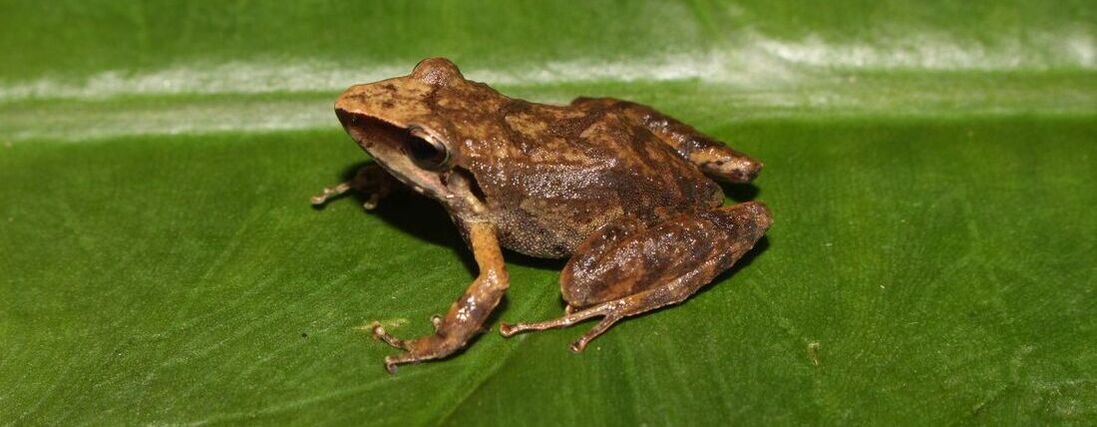
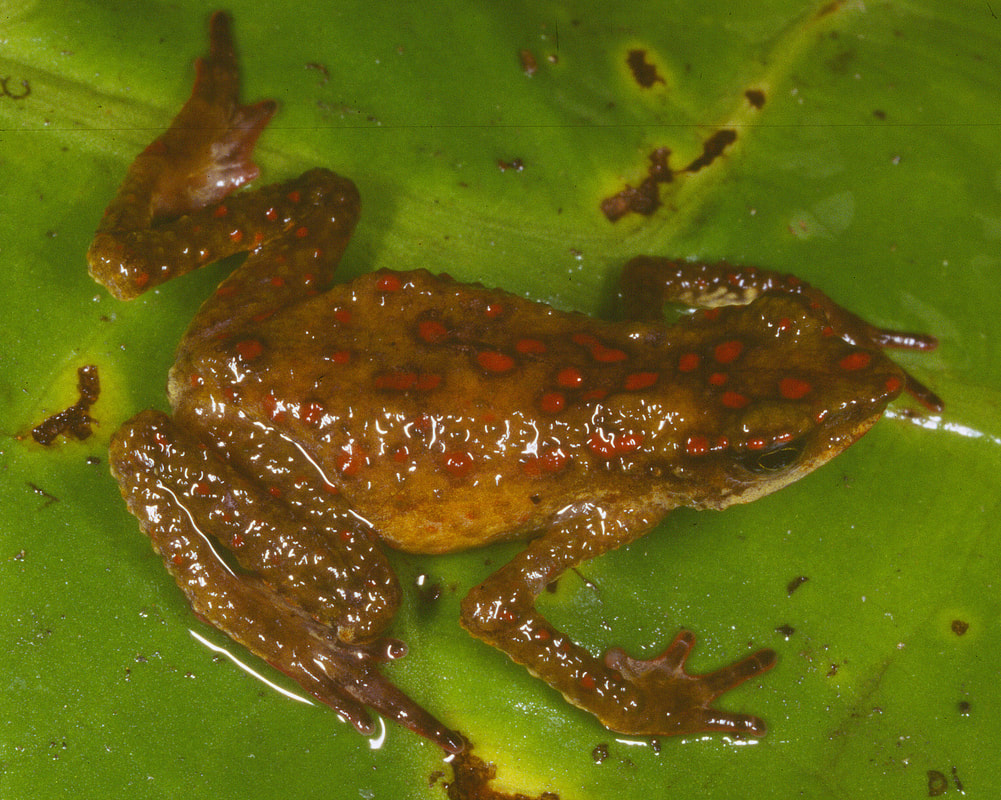
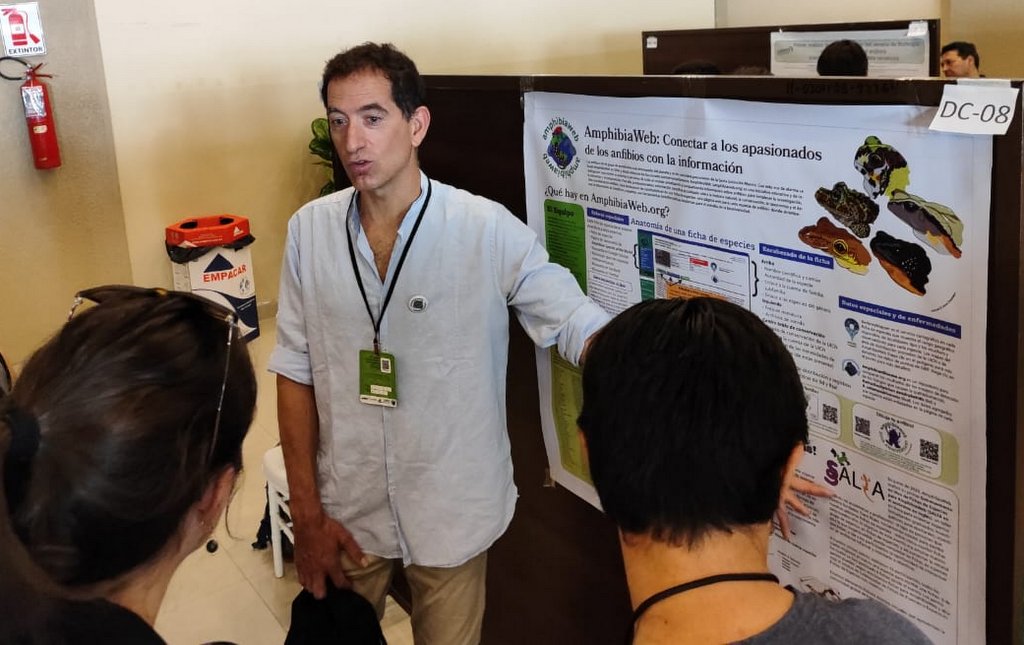
 RSS Feed
RSS Feed